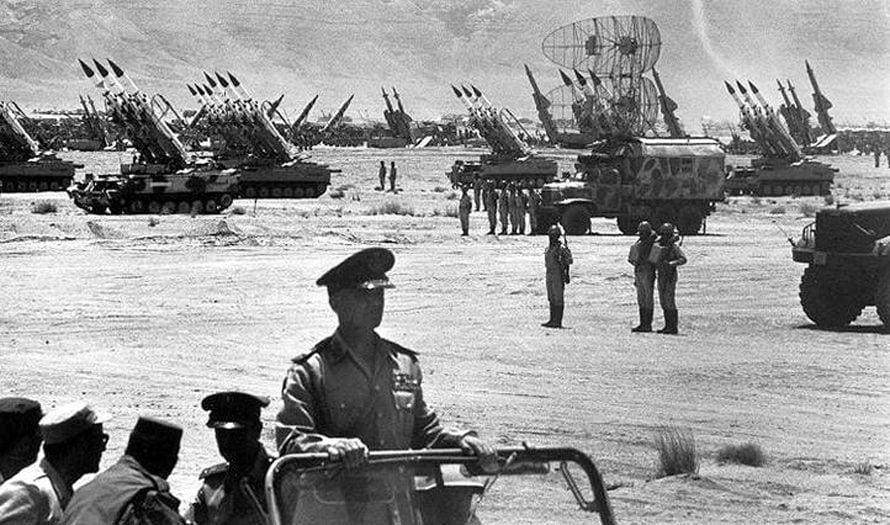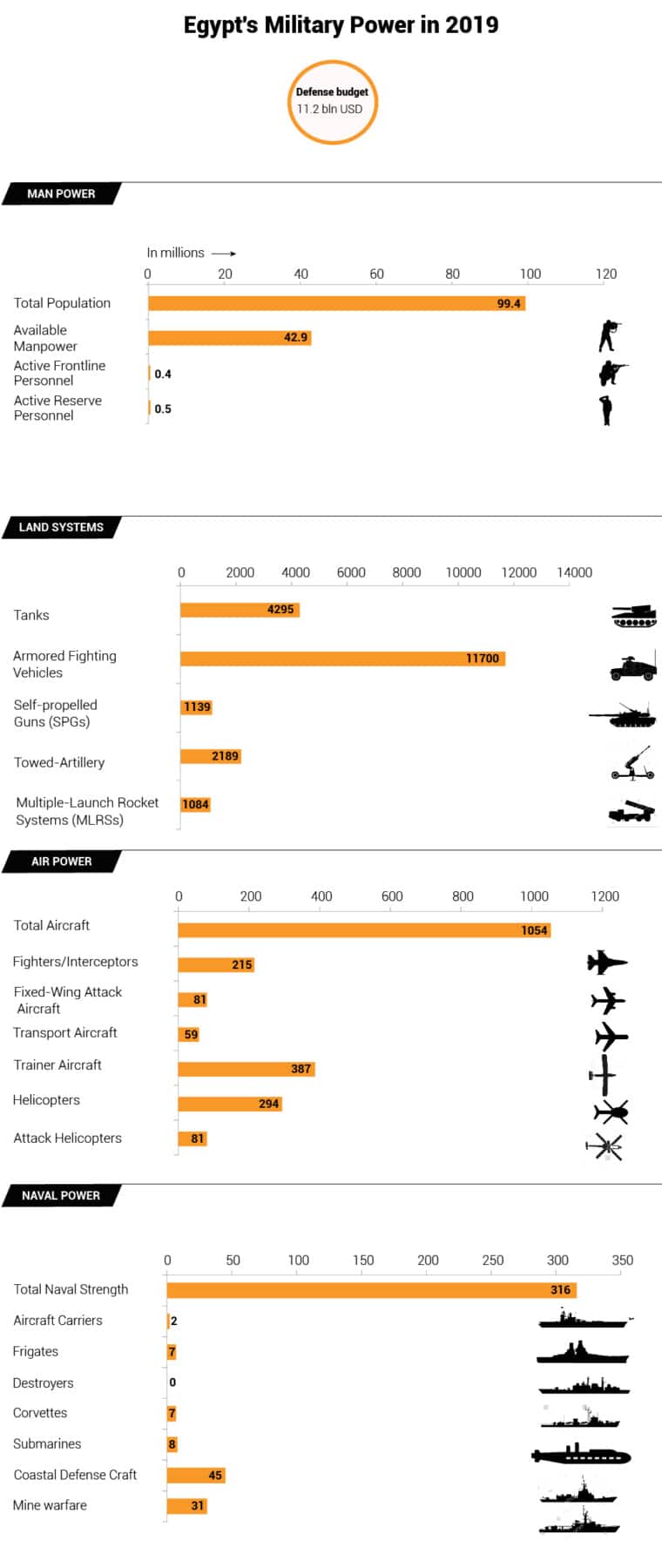
Introduction
With former general Abdel Fattah al-Sisi in power, it is unsurprising that Egypt has one of the biggest militaries in the region, coupled with a growing local defence industry that is often state supported. Even so, the country has struggled to deal with insurgent terrorist groups in the northern Sinai Peninsula in recent years.
In 2019, Egypt ranked 12 out of 137 countries included in the annual GFP review. That year, the number of people who reached military age was estimated at just over 1.5 million personnel, while military expenditure was estimated at $4.4 billion. In 2018, military expenditure accounted for 1.2 per cent of GDP, compared with 1.4 per cent in 2017 and 1.4 per cent in 2016, according to the Stockholm International Peace Research Institute.
| Index | Number | Rank out of 137 |
| Total military personnel | 920,000 | - |
| Active personnel | 440,000 | - |
| Reserve personnel | 480,000 | - |
| Total aircraft strength | 1,092 | 9 |
| Fighter aircraft | 211 | 13 |
| Attack aircraft | 341 | 8 |
| Transport aircraft | 59 | 12 |
| Total helicopter strength | 293 | 15 |
| Flight trainers | 388 | 4 |
| Combat tanks | 2,160 | 14 |
| Armoured fighting vehicles | 5,735 | 13 |
| Rocket projectors | 1,100 | 5 |
| Total naval assets | 319 | - |
| Aircraft carriers | 2 | - |
| Frigates | 9 | - |
Egypt’s military strength in 2019. Source: GFP review:
The Egyptian Armed Forces are an institution to be reckoned with. The largest in the Arab world and Africa, it ranks tenth in the world. Equipment from the former Soviet Union has been steadily replaced by modern equipment from all over the world, and Egypt is the only Arab state that owns its own reconnaissance satellites. The Armed Forces provide military assistance and training to various African and Arab states, and Egypt is a strong partner in several NATO programmes, among them the Mediterranean Dialogue.
The Armed Forces are much more than simply the military branch of the Egyptian state, charged with the defence of the borders. The Free Officers Movement, which was established as a consequence of the 1948 Arab-Israeli War, was a secret revolutionary organization, which, under the leadership of Gamal Abdel Nasser in 1952, put an end to the rule of the Egyptian king and the British military occupation of the country. Until Mohamed Morsi assumed power in the summer of 2012, the President of Egypt had always come from the military, and the recent transitional period (2011-2012) was supervised by the Supreme Council for the Armed Forces. As such, the Armed Forces have always had a large say in the affairs of the state.
Although President Morsi has attempted to curb the military’s influence by replacing key figures with Islamists or Islamist sympathizers, the military continue to hold a firm and independent position in politics and business. The Armed Forces are active in road and housing construction, military and consumer-goods production, resort and historical-monuments management, and real-estate projects. An estimated 40 percent of the Egyptian economy is controlled by the military.
The Egyptian Armed Forces consist of the Army, the Air Force, the Air-Defence Command, and the Navy, and the National Revolutionary Guard (NRG) falls under the Ministry of Defence.
The NRG consists of 60,000 personnel and is used mainly for ceremonies and parades. Its duties are to protect presidential sites and important public buildings in Cairo, protecting the highest-ranking national personalities and important foreign guests, and responding to any rebellion, coup, or other threat to presidential power. It was originally a branch of the Republican Guard, which is part of the most senior division of the Egyptian Army and bears the responsibility of defending the capital of the republic and its most important governmental and strategic industrial institutions.
The Arab Organization for Industrialization
In order to supervise the development of the Arab defence industry, Egypt, Qatar, Saudi Arabia, and the United Arab Emirates established the Arab Organization for Industrialisation (AOI) in 1975. Relations among the AOI founding members deteriorated, and Egypt has been the sole owner of the enterprise since 1993. It has more than 19,000 employees, including 1,250 engineers. The AOI owns ten factories that produce military and civilian goods; it has shares in two joint ventures and the Arab Institute for Advanced Technology.
Military Schools
The military schools of the Egyptian armed forces include the Commanders and Staff Commanders College, the Reserve Officers College, the Nasser Academy for Military Science, the Egyptian Military Academy, the Egyptian Naval Academy, the Egyptian Air Academy, the Egyptian Air Defence Academy, and the Military Technical College.
There are two paramilitary forces: the Central Security Forces fall under the Ministry of Interior, and the Border Guard Forces fall under the Ministry of Defence.
The army

Originally established under Muhammad Ali (1805-1849), who endeavoured to create a modern army, the Egyptian Army is today the largest in the Arab world and Africa. The Egyptian Army employs an estimated 975,000 (of whom 485,000 are reservists).
The army has been involved in five wars against the state of Israel – in 1948, 1956 (which also involved the United Kingdom and France), 1967, 1967-1970, and 1973. It was involved in the North Yemen civil war and the Libyan-Egyptian war of 1977, and Operation Desert Storm, against Iraq, in 1991.
One of Nasser’s aims was to create a strong army, which led him to attempt to eradicate illiteracy from the ranks of the army, in order to improve its performance. In fact, since 1967 it has been a focus of the military to educate their own, through various military colleges and academies and by enlisting university graduates. In the early 1980s, the acquisition of modern technology required properly trained enlisted personnel, and Mubarak set up successful new educational programmes.
Since the 1980s, ties have been strengthened with the United States. Eventually, this contributed to the integration of the Egyptian army in the Gulf War coalition in 1990-1991. The army formed a part of the Arab Joint Forces Command North, which exasperated Saddam Hussein, who had enjoyed the help of the Egyptian army in the Iraq-Iran War of 1980-1989.
In 1996, the Egyptian army held its largest strategic manoeuvres ever, Operation Badr, a ten-day exercise held near the Suez Canal and involving over 35,000 soldiers. Operation Badr simulated a large-scale amphibious landing on the coast of the Sinai Peninsula by a mechanized infantry battalion. The Jabal Pharon exercise on 22 April 1998 simulated joint operations against Israel, using naval and air force personnel in the Sinai. Jabal Pharon was followed by an exercise in 2001 near the city of Ismaïlia. As the exercise coincided with the intifada of al-Aqsa, it led some Israeli military experts to believe that Egypt wishes to remilitarize the Sinai.
Conscripts in the Egyptian army without a college degree serve three years, while those who obtain a secondary-school diploma are enlisted for two years. Conscripts who have a university degree serve fourteen months if enlisted and 27 months as reserve officers. The Egyptian Military Operations Authority falls under the Ministry of Defence and has its headquarters in Cairo. Although the chief-of-staff of the Armed Forces is also the chief of the Air Force and Navy, the commanders of the latter are also frequently in direct contact with the Minister of Defence.
The Air Force

The strongest in Africa and one of the strongest in the Middle East, the Egyptian Air Force (EAF) is the fourth in the world after those of the US, Israel, and Turkey and now counts 50,000 conscripts. It was formed in 1930 and became an independent branch of the Armed Forces in 1937, when it was called the Royal Egyptian Air Force. The Egyptian Air Force was initially equipped mainly by the British, but Nasser sought to replace that equipment with Soviet aircraft, mostly MiG-21s.
After the Camp David Accord, a change took place in the overall composition of the EAF, as hardware was acquired from the United States, France, and China. This caused serviceability issues that needed to be addressed by Mubarak, himself a pilot in the EAF. Under Mubarak, the majority of aircraft were F-16s and Mirages. Throughout the 1980s Egypt had a licence to build Alphajets, Tucano planes, and Westland Gazelle helicopters and it acquired Apache helicopters and Hawkeye AEWs with radar systems.
Air Marshall Ahmed Shafik – later the last Prime Minister to be appointed by Mubarak and recently also a presidential candidate – developed an ambitious plan for the modernization of the Air Force in the 1990s, acquiring more equipment from various countries, including Russia and China. In addition, steps were taken to coproduce CAC/PAC JF17 Thunders with Pakistan.
The EAF participated in all wars from the Second World War to the 1973 war with Israel, with varying results. Its most recent activity has been in the recurring US Central Command exercise Operation Bright Star. Beginning in 1980, Operation Bright Star was set up as a joint US-Egyptian air-training project to enhance performance and mutual relations. Performed in Egyptian air space, it took place almost annually until recently and involved eleven other countries and at least 70,000 personnel.[/two_third]
The Air Defence Command
Styled after the Soviet Anti-Air Defences that integrated all air-defence capabilities (anti-aircraft guns, rocket and missile units, interceptor planes, and radar and warning installations), the Air Defence Command (ADC) is responsible for Egyptian air defence. It consists of 30,000 officers and soldiers and 40,000 conscripts.
The ADC was established after Egypt’s defeat in the 1967 war against Israel, in which most Egyptian air defences were destroyed. There was a rapid build-up with Soviet equipment that was employed during the 1973 war. Since then, the ADC has been fully equipped with modern materiel, including modern low-, medium-, and high-altitude SAMs of US, French, or Russian design or built under local license.


